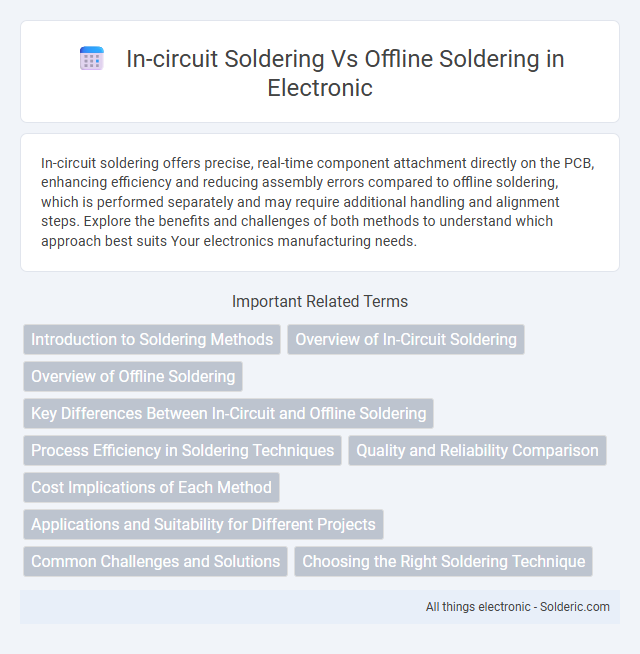In-circuit soldering offers precise, real-time component attachment directly on the PCB, enhancing efficiency and reducing assembly errors compared to offline soldering, which is performed separately and may require additional handling and alignment steps. Explore the benefits and challenges of both methods to understand which approach best suits Your electronics manufacturing needs.
Comparison Table
| Aspect | In-Circuit Soldering | Offline Soldering |
|---|---|---|
| Definition | Soldering performed directly on the assembled PCB in production line. | Soldering done separately from the main PCB assembly line, on individual components or subassemblies. |
| Process Location | On the circuit board during assembly. | Separate workstation, offline from the assembly line. |
| Speed | Faster, integrated into the production workflow. | Slower, manual or semi-automated. |
| Cost | Lower overall cost due to streamlined process. | Higher due to additional handling and labor. |
| Quality Control | Easier inline inspection and immediate rework. | Quality inspection post soldering, possibility of delayed defect detection. |
| Suitability | High-volume production, complex PCBs needing precise placement. | Low-volume or prototype production, repair, or special components. |
| Automation | Typically automated or semi-automated. | Primarily manual or semi-automated. |
Introduction to Soldering Methods
In-circuit soldering involves attaching components directly on the printed circuit board (PCB) during the assembly process, ensuring precise placement and efficient electrical connections. Offline soldering, performed separately from the main assembly line, allows for repair or specialized soldering tasks on individual components or sub-assemblies. Both methods utilize soldering techniques such as wave soldering, reflow soldering, and manual soldering to achieve reliable electronic connections.
Overview of In-Circuit Soldering
In-circuit soldering involves attaching components directly onto a fully assembled printed circuit board (PCB), enabling precise placement and immediate electrical testing within the circuit environment. This method supports a streamlined production process by minimizing handling and reducing the risk of component misalignment or damage. As a key technique in modern electronics manufacturing, in-circuit soldering enhances assembly accuracy and facilitates efficient troubleshooting.
Overview of Offline Soldering
Offline soldering involves manually assembling and soldering electronic components on a separate workstation, independent of the main circuit board. This process allows for greater flexibility in handling complex or large components that are challenging to solder in-circuit and is often used for rework or prototype development. Your production line can benefit from offline soldering by improving precision and reducing the risk of damaging sensitive components during assembly.
Key Differences Between In-Circuit and Offline Soldering
In-circuit soldering involves attaching components directly onto the PCB within the assembly line, ensuring precise placement and immediate integration into the circuit. Offline soldering, conducted separately from the main assembly process, allows for detailed manual work or rework on components before final placement. Your choice between these methods impacts production speed, quality control, and repair flexibility in electronic manufacturing.
Process Efficiency in Soldering Techniques
In-circuit soldering enhances process efficiency by allowing components to be soldered directly onto the assembled PCB, reducing handling time and minimizing potential damage from rework. Offline soldering, while offering flexibility for complex or prototype boards, often increases overall production time due to additional handling and repositioning steps. Your choice between these soldering techniques should balance throughput demands and product complexity to optimize manufacturing efficiency.
Quality and Reliability Comparison
In-circuit soldering offers superior quality and reliability by enabling precise control of solder joints directly on assembled circuits, reducing the risk of component misalignment and ensuring consistent electrical connections. Offline soldering often introduces variability due to manual handling and separate processing stages, leading to potential defects such as cold joints or solder bridges. Consequently, in-circuit soldering minimizes rework rates and enhances long-term functionality, making it the preferred method for high-reliability electronic manufacturing.
Cost Implications of Each Method
In-circuit soldering often results in lower production costs due to reduced manual labor and faster assembly times, which enhances overall manufacturing efficiency. Offline soldering, while potentially more flexible for small batch or repair work, typically incurs higher labor costs and longer processing due to separate handling stages. The choice impacts cost structures significantly, with in-circuit soldering preferred for high-volume production and offline soldering suited for specialized or low-volume tasks.
Applications and Suitability for Different Projects
In-circuit soldering excels in repairing or modifying individual components directly on assembled printed circuit boards (PCBs), making it ideal for prototypes, small batch productions, and repair tasks where precision is crucial. Offline soldering suits mass production scenarios, enabling automated, high-speed soldering of components before PCB assembly, which enhances efficiency in large-scale manufacturing. Your project's complexity and volume largely determine the choice, with in-circuit soldering favoring flexibility and offline soldering offering speed and consistency.
Common Challenges and Solutions
In-circuit soldering commonly faces challenges such as limited access to densely packed components and potential heat damage to sensitive parts, resolved through precise temperature control and specialized soldering tips. Offline soldering, while allowing better accessibility and automation, often struggles with alignment and handling variability, addressed by using fixtures and robotic arms for consistent positioning. You can improve solder joint quality and reliability by selecting the appropriate method based on component layout and employing advanced tools designed to mitigate these specific challenges.
Choosing the Right Soldering Technique
Choosing the right soldering technique depends on your project's complexity and production scale. In-circuit soldering offers precise connections directly on the assembled PCB, ideal for intricate repairs and modifications. Offline soldering provides flexibility for batch processing and component testing before final assembly, ensuring quality control and efficiency in larger manufacturing runs.
In-circuit soldering vs offline soldering Infographic

 solderic.com
solderic.com